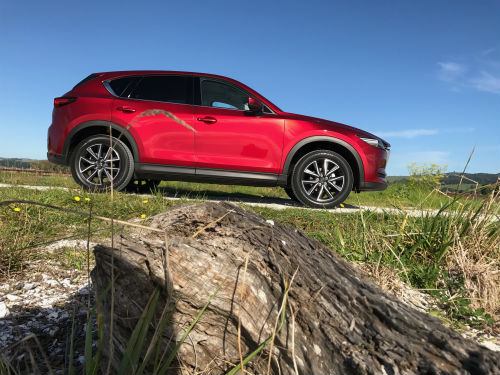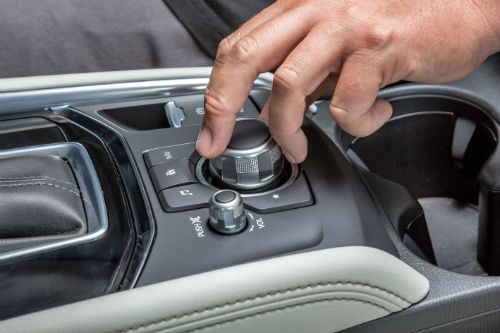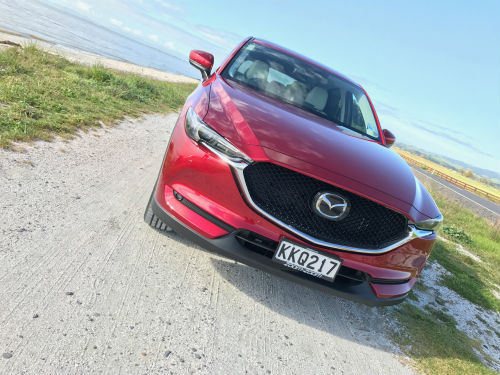Monday July 10, 2017
For: Not a rebirth yet feels reborn, improved safety suite, drives well, great engine.
Against: High-set boot floor, infotainment system demands CarPlay, six-speed auto a little off the pace.
By Richard Bosselman
WHEN the first generation CX-5 came into circulation five years ago, focus understandably fell more onto the drivetrain technology it introduced than the vehicle itself.
That’s because, back then, this medium five-seater crossover introduced something quite new to the motoring world: A suite of efficiency-minded technologies, centring on drivetrain tech, bunched under a common name, SkyActiv has been the saving of Mazda and lifted its status – and sales - hugely.
Now underpinning almost the entire Mazda range, those engines, transmissions and associated addenda are still big news items now – as well they should be, being genuine breakthrough stuff - but the car that first delivered them to the world has also created interest in its own right.
Launching this product just as the consumer swing toward sports utilities and crossovers was definitely a good fortune strategy for Mazda, though really the car’s massive rise – not just here but in every market it goes to - suggests far more than this factor alone came into it.
Anyway, it’s clear the old CX-5 was especially good for its maker and the house of Hiroshima is confident the replacement will keep on as one of the Auckland-based distributor’s strongest performers.
The remit for this second car was simple: Build on the predecessor’s many strengths, polish out its relatively few shortcomings and, above all else, keep to the overall winning recipe.
Today’s test is of the top-end opportunity, the $57,495 turbodiesel Limited with a 129kW/420Nm 2.2-litre four-cylinder.
Design
Freshening up rather than starting wholly afresh means the biggest dollar investment has gone into more advanced safety systems and an all-new body – taking clear cues from the larger CX-9 - and significantly revised interior.
The four-cylinder powertrains are largely unchanged - effort has been aimed at making the 2.5-litre petrol unit quieter and this turbodiesel smoother and official fuel consumption increases by up to half a litre per 100km (although Mazda claims all models are more efficient in the real world) – but, overall, operational aspects are unaltered, as are outputs.
The six-speed automatic is also only modestly refined, with minor ratio changes being the main alteration. Save for tune, suspension and electric steering are unchanged. A lot of other components are simply carried over.
Same wheelbase, yes, and width, but the new model fill up slightly more of a car park now, being 10mm longer. More noticeably, it has a more naturally hunkered stance, being a full 30mmm lower.
The styling is samey in general ethos, but significantly changed, in detail. The front is dominated by a bigger, bolder and more three-dimensional grille. It gets slimmer lights both front and rear, a lower bonnet and fewer accent lines on the flanks. It looks more 'premium' than it used to. That's helped by the new three-layer Soul Red Crystal paint, of which Mazda seems exceptionally proud. Agreed, it made the test car look pretty spesh … though, personally, I think the CX-5 looks best in the alternate metallic titanium, another new hue.
The cabin takes a dramatic step upmarket in terms of design and material quality, with the previous model's hard black plastics replaced by soft-touch surfaces almost everywhere.
The Limited has everything Mazda can throw at this car, but the improved ambience is common to all models. The interior is not quite Lexus-like, but you can see they’ve tried harder with a slick new floating 7.0-inch tablet screen matched to Mazda’s MZD Connect rotary dial, chunky silver dials, tactile switches and soft leather and plastic touch-points.
Finish of all cabin surfaces is really good; friends who own a previous generation car and who took a ride in this one could not get over how much Mazda had lifted its game in this respect. Mazda and Lexus find commonality with a love of two-tone leathers – mixing light with dark, in this instance cream with black. Er, no.
Pete and Lisa also enjoyed heads up display – which restricts to the Limited - and the user-experience of the infotainment, that the tablet can be used as a touchscreen (rather than via dial) to enter directions into the sat nav. On the other hand, this version of MZD seems to carry over a foible of its predecessor, in that it would occasionally freeze during an operation. It’s also disappointing that a lack of Apple CarPlay and Android Auto integration continues.
Mazda is resistant to fully autonomous cars, suggesting ‘hands-off’ jars with its intent to keep an ingredient of driver fun, but it has stepped up the suite of active safety technology – dubbed i-Activsense – that is classed as ‘level one’ autonomy.
All variants get a rear-view camera, rear sensors and autonomous emergency braking, which is now capable of also detecting pedestrians (between 10-60kmh) as well as vehicles (4-80kmh).
The Limited has Mazda radar cruise control with full stop and go functionality, traffic sign recognition, lane departure and lane-keep assistance systems as well as side camera and smart brake support. All these systems worked pretty well during our time with the car, the challenge was finding an environment in which they were useful.
Basically, that’s a multilane motorway – something that doesn’t exist around my locale. Rather, there are many country roads, whose quality of surface marking and signage was too poor for the requisite recognition process to occur. It exposes not so much a failing in the tech as in the roadscape. How can we expect these fundamental of autonomy to be useful while we still drive on goat tracks?
Another technology that has proven beneficial in the past that also struck trouble was the auto high/low beam headlamp function. The Limited has powerful lamps, with a cornering function now included, but I was left wondering if the self-dip required calibration, given that it would only sometimes enact. On other occasions oncoming motorists were flashing angrily at me. Funny, it’s never been that way on other Mazdas with this.
Practicality and seat count rate highly this category; you’re not going to see a seven-seater CX-5 – though a spin-off car currently restricted to Japan might one day meet that need – but, as a five-seater, it’s not too bad.
Back-row passengers get more legroom than before, headroom is okay and there are also now rear air vents, and a flip-down centre armrest with in-buillt storage and a USB point to charge your device. Fantastic. Entry is improved by the door apertures being wider now. Not being able to slide or recline those rear seats is a bit of a missed opportunity, perhaps.
Cargo storage is also up 39 litres to 442 – better, though still not class leading – and the back seats can flip-fold 40:20:40 via nifty levers in the cargo area if needed. There’s a high-quality sliding cargo cover fitted, a rear 12V outlet and handy shopping hooks. The boot is a little on the small side when you fold the back seats flat, but families should find it practical enough. Pet owners might think the boot lid is still a bit too high for Fido to jump, or be lifted, onto.
Driving
The CX-5 has been one of the better crossovers and SUVs to drive, and that hasn't changed; the signature hatch-like body control is particularly evident. Being a tall-roofed SUV, you'd expect it to lean and understeer and of course it does when you push it really hard, but up to that point it stays commendably flat through corners.
The steering weight is a little too light at high speeds (and a little too heavy when parking), but overall it is still a vehicle that will be untroubled winning plaudits from those who enjoy driving.
Because of its high torque output, the diesel doesn’t have the Sport mode meted the petrol models, but as with those editions it takes the G-Vectoring system from the Mazda3 and Mazda6. This tweaks back the torque of the engine under cornering loads to better balance the car. You can't really feel it working - that's the point, it's supposed to be subtle – but, again, my mates reckoned this version was more assertive than their own, so maybe that’s saying enough.
The market is trending back toward petrol in this category and, certainly, Mazda has its bases covered with its 2.0-litre and 2.5-litre normally aspirated units, though would cause more of a stir, I feel, were the stonking 2.5-litre turbo petrol that performs so brilliantly in the CX-9 came across.
However, if it were me I’d not want to write off this diesel just yet; even though it really only makes sense for buyers doing high-mileage, it’s appeal is just greater. It is just such a smooth and suave operator and there’s never a moment when that huge wave of torque doesn’t seem anything but beneficial. Maybe that’s a deceptive strength, because one thing that surprises is that the diesel’s 1800kg braked-towing legal maximum is no greater than the 2.5 petrol’s.
Mazda is about to announce its second-gen SkyActiv programme, so it’ll be interesting how much longer the current units hang about. The diesel is still hitting the target for economy, but is starting to fall back a tad on emissions (this version being slightly less Green than the last).
Perhaps it’s time for Mazda to think about the transmission, an in-house design. As six-speeds go, it’s not too bad, but industry is increasingly going to seven, eight and nine-speed boxes, and the extra benefits they provide cannot be denied.
In saying that, what this edition of the CX-5 especially doesn't lack for is refinement. All models are quieter – lengths to reducing NVH include stiffening the body, improving aero, adding sealant and reducing shut-line gaps – to the point where the company claims this generation achieves a level of quietness roughly equivalent to that of travelling 20kmh slower than on the previous model. I’d believe it.
Even so, it still impresses the heck out me that the model with what should be the noisiest engine is actually the quietest. Even at idle, it’s hard to pick up the telltale clatter and, once on the move, it becomes a silent schmooze. A lot of far more expensive engines of this calibre sound oafish by comparison.
So there’s no sound at all? Well, it’s not quite that quiet. The top models’ 19-inch alloys shod in Toyo tyres look great, but they do generate some roar over the usual surfaces that cause this (and probably add a degree of fidget to the ride quality).
Mazda's all-wheel-drive system has been updated so that it has less mechanical friction than before, to the benefit of fuel economy. It uses 27 sensors to reactively direct torque to the rear wheels when the fronts lose traction.
Can you take this car off road? In theory, there’s no reason why not, within reason. Should you? Well, I didn’t, but at this very moment another mate, Mark, who is one of the country’s four-wheel-drive experts, is running a winter conditions driving course in the deep south. And guess what he’s driving? I’ve seen lots of photos of his diesel CX-5 getting stuck into snow … but nothing of them getting stuck in it. Of course, he’s an expert, and has made smart tyre decisions, while the car’s lightness, decent clearance and manageable size are also pluses.
Decision
A process of evolution rather than revolution … Good, how many times do motoring writers wheel that one out? Still, it’s a descriptive that works particularly well for this car. Mazda hasn’t reinvented the wheel because there has been no need to.
The category is more crowded now than when the original CX-5 appeared, and the competition includes some cars that cost the same and are perceived to do and give even more – the Skoda Kodiaq being one particularly good example.
Even so, Mazda has every reason to hold high confidence in this car continuing where its predecessor left off.


